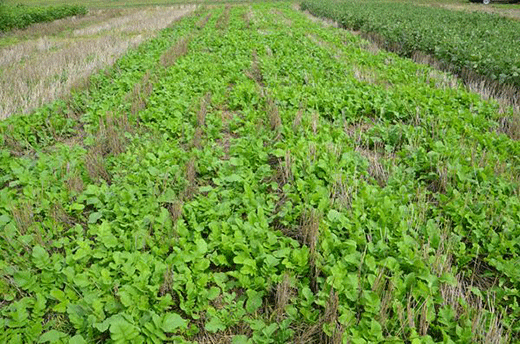
Cover crops are a good management strategy to help reduce soil erosion, suppress weeds and increase the soil nutrient profile. A publication from Kansas State University can help cattle producers know which cover crops could be toxic to cattle. | Download this photo.
K-State: Know risks to livestock before planting cover crops
Publication outlines threats, benefits of common varieties
April 4, 2019
PARSONS, Kan. – A Kansas State University extension specialist is encouraging the state’s cattle producers to study up on some of the more common cover crops before they plant this spring.
Jaymelynn Farney, a beef systems specialist at the Southeast Research-Extension Center in Parsons, said many cover crops could be toxic to livestock that may be grazing those crops later in the year.
“Unfortunately, due to the nature of the plant growth physiology, most cover crops grow rapidly,” Farney said. “In growing rapidly, they accumulate a lot of nitrates.”
Cover crops have become popular because they help to reduce soil erosion, suppress weeds and increase the soil nutrient profile. They can also provide quality forage in place of fallow during key production periods.
But there have been recent news reports of cattle in Missouri that were poisoned after eating sorghum-sudangrasses that were later determined to be high in nitrates. In an animal’s stomach, nitrate is converted to nitrite, which is easily absorbed into the blood stream where it converts blood hemoglobin into methemoglobin, which cannot carry oxygen.
“If you’re feeding any sorghum-sudan type of hays, or pearl millets, please test them for nitrate prior to feeding them to your cattle,” Farney said. “A $15 test can save you a lot of money in the long run.”
She also pointed to a K-State publication, titled Forage Crops Grazing Management: Toxic Plants, which outlines many of the cover crops commonly planted in Kansas, as well as their potential risk to cattle.
That publication is available online from the K-State Research and Extension bookstore.
Farney noted that one particular cover crop, hairy vetch, is often responsible for metabolic disorders in cattle. It’s listed on the U.S. Department of Agriculture’s poisonous plants registry for livestock.
Hairy vetch works well to fix the nitrogen profile in a field, but is not recommended for grazing.
“The thing that concerns me the most about hairy vetch is we still don’t know what the direct toxin is that causes issues with cattle,” Farney said. “The symptoms are very clear when you know you have a hairy vetch (poisoning). Those calves…develop nasty scales around their neck, it impedes their breathing rates, and eventually gets into their kidneys. The greatest cause of death is due to kidney malfunction.”
There is no genetic test to indicate livestock’s sensitivity to hairy vetch. The mortality rate for affected animals ranges from 50 to 100 percent.
Farney said the K-State publication also covers the risks and benefits of two other potentially poisonous plants, lupins and amaranth; as well as cover crops that may cause metabolic disorders, including the brassicas.
Recommendations for feeding flax, small grains and legumes are also covered.
Farney said the Midwest Cover Crop Council provides an online decision tool for producers. The program allows producers to pick their state and county, then by inputting crop rotations and goals they want to achieve with cover crops, the decision tool provides a list of suitable cover crops and estimated planting dates.
The decision tool is available online.
Producers can also contact their local extension agent for information or advice on planting cover crops.
-30-
K‑State Research and Extension is a short name for the Kansas State University Agricultural Experiment Station and Cooperative Extension Service, a program designed to generate and distribute useful knowledge for the well‑being of Kansans. Supported by county, state, federal and private funds, the program has county extension offices, experiment fields, area extension offices and regional research centers statewide. Its headquarters is on the K‑State campus in Manhattan. For more information, visit www.ksre.ksu.edu
Story by:
Pat Melgares
785-532-1160
For more information:
Jaymelynn Farney
620-820-6125

